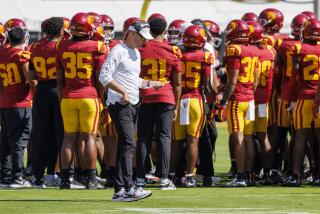A Lot of Kickers Seek a Safe Place
- Share via
As a rule, David Newbury does not read the sports page.
Even after the USC kicker made the game-winning field goal against Colorado last weekend--and his picture was in the newspapers--he tried not to look.
That’s what happens when a kicker makes a big field goal but misses two other attempts. That’s what happens when he is coming off an 11-for-20 season and scrutiny in the press.
“You try to avoid reading that,” he said. “You can’t let things get in your head.”
It’s not only Newbury.
Adam Abrams ran hot and cold during his Trojan career in the late 1990s. Cole Ford struggled before that, kicking inconsistently in 1992 before improving as a senior.
No USC kicker has made an attempt from 50 yards since 1990. No recent kicker has made all-conference, as Chris Limahelu did in 1972, or matched the reliability of Steve Jordan, who kicked two 51-yard field goals against Ohio State in the 1985 Rose Bowl.
“SC had a great string of kickers at one point,” said Dan Ferrigno, who took over coaching special teams for USC this season. “Now, recently, we’ve struggled a little bit.”
This season, the kicking game is a question mark on a team that has a veteran defense and Carson Palmer at quarterback. The deficiency shows up on the scoreboard. It factors into any fourth-down decision inside the 30-yard line.
It has even forced the team to spend more time practicing fakes, Coach Paul Hackett said.
Before the season, Hackett dryly joked about studying the art and psychology of kicking. His humor pointed to the complexity of the undertaking.
Each time a kicker tries a field goal, a dozen things can go wrong. He must worry about how quickly he approaches the ball and where he plants his left foot.
Plant it too far in front of the ball, the kick sails wide right. Plant it too far behind the ball, his hips rotate and the kick goes left.
Some experts compare kicking to golf. Like a golfer, a kicker must keep his head down and follow through. But, unlike golf, there are factors beyond the kicker’s control.
The snap. The holder. The 300-pound rusher busting through the middle of the line.
In struggling to find a reliable kicker, USC has faced a problem common to other schools, a problem that began when the NCAA prohibited the use of tees for field goals and extra points in 1989.
Since then, recruiters have struggled to evaluate high school players who continue to use one- and two-inch tees.
“The kid goes to college and goes to the ground and, believe me, it’s an entirely different sequence,” said Ray Pelfrey, who runs a popular kicking camp in Sparks, Nev. “They have to be completely retrained as far as speed to the ball and foot placement.”
Abrams is an example. The Trojans won a recruiting war with Notre Dame to get the consensus high school All-American in 1994, only to watch him have a streaky four seasons in college.
So is it simply luck that some kickers make the transition while others fail? Pelfrey doesn’t think so. He cites Ford as an example.
After a rough season at USC, Ford was worried about being replaced by the newly recruited Abrams and spent the summer working with Pelfrey. His senior season, he kept his job, finished a respectable 14 of 19 and ended up playing for the Oakland Raiders.
“If a boy is coached well, he doesn’t miss that many field goals,” said Pelfrey, who is related to, and once coached, former Cincinnati Bengal kicker Doug Pelfrey.
The problem is, not all colleges have coaches who know the intricacies of kicking, Ray Pelfrey said. However, he did praise Ferrigno, perhaps because the new USC coach has attended Pelfrey’s camps.
Having coached special teams at California and Oregon State, Ferrigno says USC has the talent to turn its kicking game around.
He believes all of his kickers--Newbury, David Bell and freshman John Wall--have strong enough legs. He does not ask that they use any particular style--such as European, American or wedge--only that they stick to one style and polish their technique.
“You don’t want to change them or give them too many things to think about,” he said. “You get them thinking too much, then you’ve got problems.”
Newbury couldn’t agree more.
Last season, coming from a Texas junior college, he was asked to alter his technique, shortening his setup steps. He says he never got comfortable, started tinkering with other aspects of his technique and promptly started missing kicks.
Technical problems led to his slump. Not being relaxed. Rushing to the ball.
Even though Ferrigno has allowed him to return to his natural setup, these familiar culprits showed up on his misses against Colorado.
So Newbury realizes he has a way to go before he becomes a consistent kicker.
“I’ve got to get back on target,” he said. “Back to my tempo.”
Another reason to avoid the newspapers after his game-winning field goal last Saturday. Newbury did not want to read the positive things written about him.
That last-second kick might boost his confidence a little, he said, but it won’t put any points on the scoreboard when USC plays San Jose State on Sept. 23.
“You don’t want to think everything is going fine when it’s not,” he said. “You want to get back to work.”
*
UP NEXT
San Jose State at USC
Sept. 23
3:30 p.m.
Fox Sp. Net 2
BRUINS
PLEASED
Scott McEwan didn’t win the quarterback job last week, but he impressed the coaches. Page 12
More to Read
Fight on! Are you a true Trojans fan?
Get our Times of Troy newsletter for USC insights, news and much more.
You may occasionally receive promotional content from the Los Angeles Times.







